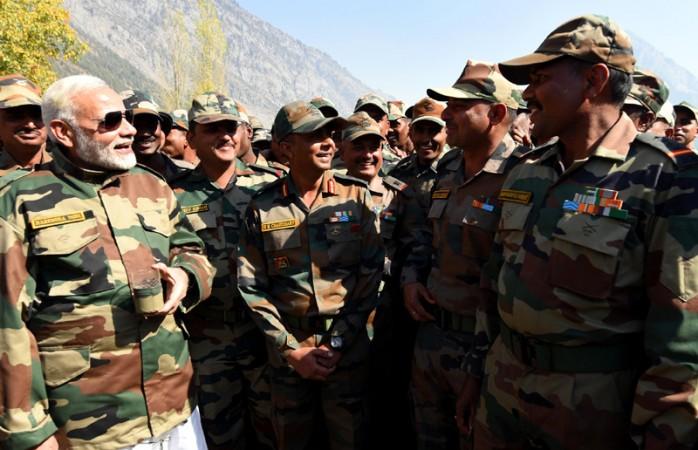
The bonhomie between Pakistan and China is a well-known fact. In an extremely worrisome move, a fresh Intelligence Bureau report states that both China and Pakistan have come together to set up a module exclusively to honey-trap Indian Army personnel.
The module works out of two locations, the report states. While one unit is based in Karachi, the other was set up in Bangladesh. The alert comes in the wake of the Indian Defence Ministry directing its troops to immediately delete 40 Chinese applications from their phones. These applications were being used to source location information of the Indian troops posted both at the Pakistan and Chinese border.
Modus operandi:
The information exclusively available with International Business Times, India, states that the modules comprise both Chinese and Pakistani operatives. While the Pakistanis make the call in Hindi, the Chinese women speak English. The Chinese have developed applications through which they first track and understand the internet habits of the Indian officers. Those persons using Chinese smartphones are particularly vulnerable, the report states.

The trap is often laid on the social media sites. WhatsApp is another medium through which these traps are laid. What is even more worrisome is that both the Chinese and Pakistanis have set up their moles in India as well. Once they manage to trap the person, they set up a meeting at a coffee shop.
In this modus operandi, the use of money has been completely restricted. Both the Chinese and Pakistanis feel that money leaves a trail and hence must be avoided. While quoting one such instance in which an officer was trapped, the report states that the lady enticed him by saying that she was lonely and had a broken marriage.
What the officer never realised that the entire act was being video-recorded. Once the meeting is done, the video is played out to blackmail the officer into giving out secret information.
300-member module:
The module is a large one, the report states. It is the Chinese who develop the technology while the Pakistanis set up the trap. Two officers of the ISI Sajid Rana and Abid are overseeing this entire module.
The module apart from setting up honey traps also are actively involved in hacking phones and systems of the Indian officials. The Chinese set up a chatting application through which they target phones using the Trojan malware, the report also states. The most lethal application was the Smeshapp which could be installed both on the desktop as well as the mobile phones.
Through this application, the Chinese and Pakistanis have managed to get information on troop movement and deployment. The data that was installed on the phones of these persons have been compromised on various occasions, the report states.
Although the Smeshapp was taken down by Google Play, the module continues to promote it as a chatting interface on the social media. An ID is created by the module member on Facebook and fake images are used.
A team within the module then goes about identifying persons to target. Once the target is identified, images are exchanged and calls are made.
The report also states that there was another instance in which a defence portal had been created by the module. The portal promised to give credible data and any officer logging into it would become vulnerable to a Trojan malware attack. Once the malware takes over the system or phone all data on it would be compromised, the report also stated.
Directive to delete applications:
The Defence Ministry had recently written to the armed forces to delete 40 Chinese applications. The directive was issued based on the threat perception.
Some of the apps that have been ordered to be deleted were Weibo, Wechat, Beautyplus, Nes Dog, CM Browser, MI Community, DU Privacy and Selfie City, Mail Master and MI Video call-Xiaomi.
The advisory had stated that these applications have their servers in China and they would be able to track troop movement through it. The advisory also noted that the deployment of forces was also being tracked through these applications.

Further, the Indian government has also insisted on specific clearance for Chinese telecom products. Companies such as ZTE and Huawei have not been allowed to install their towers in the border areas. Intelligence Bureau officials say that these products have their master servers in China and can track troop movement and deployment.


![Too drunk to walk? Karnataka to drop heavily intoxicated revellers home, sets up rest centres for New Year crowds [Watch] Too drunk to walk? Karnataka to drop heavily intoxicated revellers home, sets up rest centres for New Year crowds [Watch]](https://data1.ibtimes.co.in/en/full/826552/too-drunk-walk-karnataka-drop-heavily-intoxicated-revellers-home-sets-rest-centres-new-year.png?w=220&h=135&l=50&t=40)








![Too drunk to walk? Karnataka to drop heavily intoxicated revellers home, sets up rest centres for New Year crowds [Watch]](https://data1.ibtimes.co.in/en/full/826552/too-drunk-walk-karnataka-drop-heavily-intoxicated-revellers-home-sets-rest-centres-new-year.png?w=220&h=138)
![Too drunk to walk? Karnataka to drop heavily intoxicated revellers home, sets up rest centres for New Year crowds [Watch]](https://data1.ibtimes.co.in/en/full/826552/too-drunk-walk-karnataka-drop-heavily-intoxicated-revellers-home-sets-rest-centres-new-year.png?w=220&h=135)


